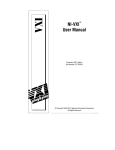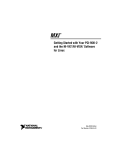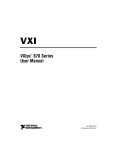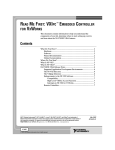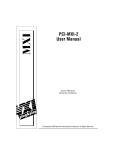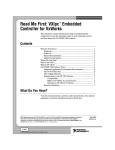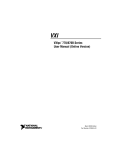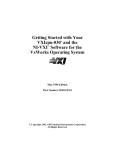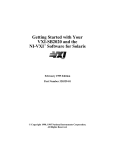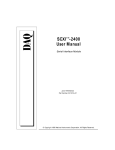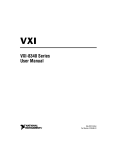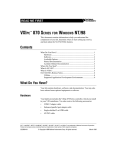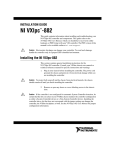Download Getting Started with Your VXIpc-850
Transcript
Getting Started with Your VXIpc -850 ™ April 1996 Edition Part Number 321123B-01 © Copyright 1996 National Instruments Corporation. All Rights Reserved. Internet Support GPIB: [email protected] DAQ: [email protected] VXI: [email protected] LabVIEW: [email protected] LabWindows: [email protected] HiQ: [email protected] VISA: [email protected] E-mail: [email protected] FTP Site: ftp.natinst.com Web Address: http://www.natinst.com Bulletin Board Support BBS United States: (512) 794-5422 or (800) 327-3077 BBS United Kingdom: 01635 551422 BBS France: 1 48 65 15 59 FaxBack Support (512) 418-1111 Telephone Support (U.S.) Tel: (512) 795-8248 Fax: (512) 794-5678 International Offices Australia 03 9 879 9422, Austria 0662 45 79 90 0, Belgium 02 757 00 20, Canada (Ontario) 519 622 9310, Canada (Québec) 514 694 8521, Denmark 45 76 26 00, Finland 90 527 2321, France 1 48 14 24 24, Germany 089 741 31 30, Hong Kong 2645 3186, Italy 02 413091, Japan 03 5472 2970, Korea 02 596 7456, Mexico 95 800 010 0793, Netherlands 0348 433466, Norway 32 84 84 00, Singapore 2265886, Spain 91 640 0085, Sweden 08 730 49 70, Switzerland 056 200 51 51, Taiwan 02 377 1200, U.K. 01635 523545 National Instruments Corporate Headquarters 6504 Bridge Point Parkway Austin, TX 78730-5039 Tel: (512) 794-0100 Important Information Warranty The National Instruments VXIpc-850 Series embedded computers and accessories are warranted against defects in materials and workmanship for a period of one year from the date of shipment, as evidenced by receipts or other documentation. National Instruments will, at its option, repair or replace equipment that proves to be defective during the warranty period. This warranty includes parts and labor. The media on which you receive National Instruments software are warranted not to fail to execute programming instructions, due to defects in materials and workmanship, for a period of 90 days from date of shipment, as evidenced by receipts or other documentation. National Instruments will, at its option, repair or replace software media that do not execute programming instructions if National Instruments receives notice of such defects during the warranty period. National Instruments does not warrant that the operation of the software shall be uninterrupted or error free. A Return Material Authorization (RMA) number must be obtained from the factory and clearly marked on the outside of the package before any equipment will be accepted for warranty work. National Instruments will pay the shipping costs of returning to the owner parts which are covered by warranty. National Instruments believes that the information in this manual is accurate. The document has been carefully reviewed for technical accuracy. In the event that technical or typographical errors exist, National Instruments reserves the right to make changes to subsequent editions of this document without prior notice to holders of this edition. The reader should consult National Instruments if errors are suspected. In no event shall National Instruments be liable for any damages arising out of or related to this document or the information contained in it. EXCEPT AS SPECIFIED HEREIN , N ATIONAL INSTRUMENTS MAKES NO WARRANTIES, EXPRESS OR IMPLIED, AND SPECIFICALLY DISCLAIMS ANY WARRANTY OF MERCHANTABILITY OR FITNESS FOR A PARTICULAR PURPOSE. C USTOMER’S RIGHT TO RECOVER DAMAGES CAUSED BY FAULT OR NEGLIGENCE ON THE PART OF NATIONAL INSTRUMENTS SHALL BE LIMITED TO THE AMOUNT THERETOFORE PAID BY THE CUSTOMER . NATIONAL INSTRUMENTS WILL NOT BE LIABLE FOR DAMAGES RESULTING FROM LOSS OF DATA , PROFITS, USE OF PRODUCTS, OR INCIDENTAL OR CONSEQUENTIAL DAMAGES , EVEN IF ADVISED OF THE POSSIBILITY THEREOF. This limitation of the liability of National Instruments will apply regardless of the form of action, whether in contract or tort, including negligence. Any action against National Instruments must be brought within one year after the cause of action accrues. National Instruments shall not be liable for any delay in performance due to causes beyond its reasonable control. The warranty provided herein does not cover damages, defects, malfunctions, or service failures caused by owner’s failure to follow the National Instruments installation, operation, or maintenance instructions; owner’s modification of the product; owner’s abuse, misuse, or negligent acts; and power failure or surges, fire, flood, accident, actions of third parties, or other events outside reasonable control. Copyright Under the copyright laws, this publication may not be reproduced or transmitted in any form, electronic or mechanical, including photocopying, recording, storing in an information retrieval system, or translating, in whole or in part, without the prior written consent of National Instruments Corporation. Trademarks LabVIEW®, NI-488.2™, NI-VISA™, NI-VXI™, TNT™, and VXIpc™ are trademarks of National Instruments Corporation. Product and company names listed are trademarks or trade names of their respective companies. WARNING REGARDING MEDICAL AND CLINICAL USE OF NATIONAL INSTRUMENTS PRODUCTS National Instruments products are not designed with components and testing intended to ensure a level of reliability suitable for use in treatment and diagnosis of humans. Applications of National Instruments products involving medical or clinical treatment can create a potential for accidental injury caused by product failure, or by errors on the part of the user or application designer. Any use or application of National Instruments products for or involving medical or clinical treatment must be performed by properly trained and qualified medical personnel, and all traditional medical safeguards, equipment, and procedures that are appropriate in the particular situation to prevent serious injury or death should always continue to be used when National Instruments products are being used. National Instruments products are NOT intended to be a substitute for any form of established process, procedure, or equipment used to monitor or safeguard human health and safety in medical or clinical treatment. FCC/DOC Radio Frequency Interference Class A Compliance This equipment generates and uses radio frequency energy and, if not installed and used in strict accordance with the instructions in this manual, may cause interference to radio and television reception. Classification requirements are the same for the Federal Communications Commission (FCC) and the Canadian Department of Communications (DOC). This equipment has been tested and found to comply with the following two regulatory agencies: Federal Communications Commission This equipment has been tested and found to comply with the limits for a Class A digital device, pursuant to part 15 of the FCC Rules. These limits are designed to provide reasonable protection against harmful interference when the equipment is operated in a commercial environment. This equipment generates, uses, and can radiate radio frequency energy and, if not installed and used in accordance with the instruction manual, may cause harmful interference to radio communications. Operation of this equipment in a residential area is likely to cause harmful interference in which case the user will be required to correct the interference at his own expense. Notices to User: Changes or modifications not expressly approved by National Inst ruments could void the user’s authority to operate the equipment under the FCC Rules. This device complies with the FCC rules only if used with shielded interface cables of suitable quality and construction. National Instruments used such cables to test this device and provides them for sale to the user. The use of inferior or nonshielded interface cables could void the user's authority to operate the equipment under the FCC rules. If necessary, consult National Instruments or an experienced radio/television technician for additional suggestions. The following booklet prepared by the FCC may also be helpful: Interference to Home Electronic Entertainment Equipment Handbook. This booklet is available from the U.S. Government Printing Office, Washington, DC 20402. Canadian Department of Communications This Class A digital apparatus meets all requirements of the Canadian Interference-Causing Equipment Regulations. Cet appareil numérique de la classe A respecte toutes les exigences du Règlement sur le matériel brouilleur du Canada. Table of Contents About This Manual Organization of This Manual........................................................................................vii Conventions Used in This Manual................................................................................ viii How to Use This Documentation Set............................................................................viii Related Documentation ................................................................................................ ix Customer Communication ............................................................................................ix Chapter 1 Introduction What You Need to Get Started .....................................................................................1-1 Hardware Description ...................................................................................................1-1 Software Description ....................................................................................................1-2 Software Configurations ................................................................................ 1-2 Optional Software .........................................................................................................1-3 Chapter 2 Setup Hardware Installation....................................................................................................2-1 Setting up the VXIpc-850 .............................................................................................2-2 Windows Users .............................................................................................. 2-2 DOS Users...................................................................................................... 2-3 VME Users .....................................................................................................2-4 Device Interaction.........................................................................................................2-4 Chapter 3 Default Settings Appendix A Specifications © National Instruments Corporation v Getting Started with Your VXIpc-850 Table of Contents Appendix B Customer Communication Glossary Index Tables Table 3-1. Table 3-2. Table 3-3. Table 3-4. VXIpc-850 Hardware Default Settings ...............................................3-1 Logical Address Configuration Editor Default Settings...................... 3-2 Device Configuration Editor Default Settings .................................... 3-3 Bus Configuration Editor Default Settings..........................................3-3 Getting Started with Your VXIpc-850 vi © National Instruments Corporation About This Manual You can use this manual to help you get a quick start with the VXIpc-850 Series embedded computer and the NI-VXI software. This manual summarizes the setup instructions and default settings for the hardware and software. You may find that these sections contain as much information as you need to get started with your VXIpc-850 kit. Organization of This Manual This manual is organized as follows: • Chapter 1, Introduction , describes the VXIpc-850 Series of embedded VXI computers along with the NI-VXI software, lists what you need to get started, and lists optional software. • Chapter 2, Setup, contains basic instructions for setting up the VXIpc-850 and the NI-VXI software. • Chapter 3, Default Settings, summarizes the hardware and software default settings for the VXIpc-850 kit. If you need more information about a particular setting or if you want to try a different configuration, refer to the user manuals in your kit. • Appendix A, Specifications, describes the environmental, electrical, and mechanical specifications of the VXIpc-850. • Appendix B, Customer Communication, contains forms you can use to request help from National Instruments or to comment on our products and manuals. • The Glossary contains an alphabetical list and description of terms used in this manual, including abbreviations, acronyms, metric prefixes, mnemonics, and symbols. • The Index contains an alphabetical list of key terms and topics in this manual, including the page where you can find each one. © National Instruments Corporation vii Getting Started with Your VXIpc-850 About This Manual Conventions Used in This Manual The following conventions are used in this manual: bold Bold text denotes menus, menu items, or dialog box buttons or options. bold monospace Bold text in this font denotes the messages and responses that the computer automatically prints to the screen. italic Italic text denotes emphasis, a cross reference, or an introduction to a key concept. monospace Text in this font denotes text or characters that are to be literally input from the keyboard, sections of code, programming examples, and syntax examples. This font is also used for the proper names of programs, subprograms, functions, filenames, and extensions. ♦ The ♦ symbol indicates that the text following it applies only to a specific operating system. Abbreviations, acronyms, metric prefixes, mnemonics, symbols, and terms are listed in the Glossary. How to Use This Documentation Set Begin by reading this manual, Getting Started with Your VXIpc-850, for basic instructions on setting up the hardware and software. This is a brief quick start manual that describes how to get started with your kit using the default hardware and software settings. Refer to the following manuals for more information about the hardware or software. The VXIpc-850 Series User Manual contains more details about changing the installation or configuration from the defaults, and using the hardware. The VXIpc-850 Peripherals User Manual contains in-depth information about configuring and using various peripherals on the VXIpc-850. Getting Started with Your VXIpc-850 viii © National Instruments Corporation About This Manual The NI-VXI Software Manual for the VXIpc-850 Series contains more details about changing the NI-VXI software installation or configuration from the defaults, and using the NI-VXI software on the VXIpc-850. When you are familiar with the material in this getting started manual, you can begin to use the NI-VXI Software Reference Manual for C. Chapter 1, Introduction to VXI, and Chapter 2, Introduction to the NI-VXI Functions, present the concepts of VXI and prepare you for detailed explanations of the NI-VXI functions. Study the descriptions of each function given in Chapters 3 through 13 to fully understand the purpose and syntax of each function. Refer to the NI-VXI Graphical Utilities Reference Manual and the NI-VXI Text Utilities Reference Manual to learn more about the NI-VXI utilities. Related Documentation The following documents contain information that you may find helpful as you read this manual: • ANSI/IEEE Standard 1014-1987, IEEE Standard for a Versatile Backplane Bus: VMEbus • ANSI/IEEE Standard 1155-1993, IEEE VMEbus Extensions for Instrumentation: VXIbus • ANSI/VITA 1-1994, VME64 • VXI-6, VXIbus Mainframe Extender Specification, Rev. 1.0, VXIbus Consortium Customer Communication National Instruments wants to receive your comments on our products and manuals. We are interested in the applications you develop with our products, and we want to help if you have problems with them. To make it easy for you to contact us, this manual contains comment and configuration forms for you to complete. These forms are in Appendix B, Customer Communication, at the end of this manual. © National Instruments Corporation ix Getting Started with Your VXIpc-850 Chapter 1 Introduction This chapter describes the VXIpc-850 Series of embedded VXI computers along with the NI-VXI software, lists what you need to get started, and lists optional software. What You Need to Get Started VXIpc-850 embedded controller VXIbus mainframe Keyboard (and included adapter cable) PS/2 mouse Monitor with VGA or better resolution The following items are already installed on your VXIpc-850 computer. They are also included on disk in the event that you need to reinstall your software. LabWindows ® /CVI Run-Time Engine (for Windows 95/NT/3.1 users) NI-VXI software media for the VXIpc-850 Series Hardware Description The VXIpc-850, a Pentium-based, C-size embedded computer based on the Peripheral Component Interface (PCI) bus, is a high-performance, easy-to-use platform for controlling VXIbus systems, featuring complete VXI functionality through interactive utilities and C function calls. In addition, the VXIpc-850 has an IEEE 488 interface that is compatible with the NI-488.2 architecture. © National Instruments Corporation 1- 1 Getting Started with Your VXIpc-850 Chapter 1 Introduction The VXIpc-850 is a custom computer that you install directly in two C-size slots of your VXIbus mainframe. It can take advantage of the VXI high-performance backplane capabilities and give you direct control of VXI registers, memory, interrupts, and triggers. All models in the VXIpc-850 Series are fully VXIplug&play compliant and can be used with PC-compatible software tools, the National Instruments LabVIEW and LabWindows/CVI application software, and the NI-VXI, NI-VISA, and NI-488.2 bus interface software. For in-depth details on the VXIpc-850 hardware, consult the VXIpc-850 Series User Manual. The VXIpc-850 Peripherals User Manual describes how to configure and use various peripherals with your VXIpc-850. Software Description The NI-VXI bus interface software for the VXIpc-850 Series includes a VXI/MXI Resource Manager, graphical and text-based versions of an interactive VXI resource editor program, a comprehensive library of software routines for VXI programming, and a VXI interactive control program. You can use this software to create applications that seamlessly control multiple-mainframe configurations. These applications have software compatibility across a variety of VXI controller platforms. For more information on installing and configuring the NI-VXI software, refer to the NI-VXI Software Manual for the VXIpc-850 Series. This manual describes each field in the VXIpc Configuration Editor of the VXIedit software utility. You can use the NI-VXI Graphical Utilities Reference Manual and the NI-VXI Text Utilities Reference Manual to get more information about the VIC or VICtext utilities and the other configuration editors in VXIedit. Refer to the NI-VXI Software Reference Manual for C for details about NI-VXI function calls. Software Configurations There are four software configurations described in this manual: • Getting Started with Your VXIpc-850 NI-VXI for DOS/Windows 3.1—you can use this version of the software to develop and run 16-bit DOS/ Windows 3.1 applications. You can also use this software under Windows 95 if you intend to use 16-bit applications only. 1- 2 © National Instruments Corporation Chapter 1 Introduction • NI-VXI Upgrade for Windows 95—this is a compatibility release that extends your NI-VXI for DOS/Windows 3.1 to allow 32-bit applications running in Windows 95 to use the 16-bit driver. In this configuration you can run both 16-bit and 32-bit applications; however, the core of the driver is 16-bit. • NI-VXI for Windows 95—this is a fully 32-bit native Plug and Play driver for Windows 95. You can run only 32-bit applications with this driver. You cannot use this driver in conjunction with either NI-VXI for DOS/Windows 3.1 or the NI-VXI Upgrade for Windows 95 to run 16-bit applications. Applications developed using this driver will run with NI-VXI for Windows NT without the need to recompile. • NI-VXI for Windows NT—this is a 32-bit driver designed for Windows NT. You can use this version to develop and run 32-bit applications for Windows 95/NT. Optional Software Your VXIpc-850 kit includes the NI-VXI bus interface software. In addition, you can use the National Instruments LabVIEW and LabWindows/CVI application programs and instrument drivers to ease your programming tasks. These standardized programs match the modular virtual instrument capability of VXI and can reduce your VXI/VMEbus software development time. These programs are fully VXIplug&play compliant and feature extensive libraries of VXI instrument drivers written to take full advantage of the VXI bus. LabVIEW and LabWindows/CVI include all the tools needed for instrument control, data acquisition, analysis, and presentation. When you order the LabVIEW VXI Development System for Windows or the LabWindows/CVI VXI Development System for Windows, you also get more than 500 complete instrument drivers, which are modular, source-code programs that handle the communication with your instrument to speed your application development. © National Instruments Corporation 1- 3 Getting Started with Your VXIpc-850 Chapter 2 Setup This chapter contains basic instructions for setting up the VXIpc-850 and the NI-VXI software. You can use this material as a guide to quickly configure and operate your VXI system using the VXIpc-850. This chapter assumes that you intend to perform a basic configuration as follows: • You have one VXIbus chassis in which you will be using the VXIpc-850 as the Resource Manager (logical address 0). • You will be using the NI-VXI software for initialization, configuration, and device interaction. • You will use the default hardware and software settings. Refer to Chapter 3 of this manual for a complete listing of the hardware and software default settings. If you need more information, or if you want to try a different configuration, please refer to the VXIpc-850 Series User Manual for information about the hardware, or to the NI-VXI Software Manual for the VXIpc-850 Series for information about the NI-VXI software. Hardware Installation To prevent electrostatic discharge, touch the antistatic plastic package to a metal part of your VXIbus chassis before removing the VXIpc-850 from the package. Install the VXIpc-850 in the first slot of a VXI chassis (slot 0). The VXIpc-850 default configuration automatically detects whether it should be the VXIbus system controller. The VXIbus system controllers operate certain VXIbus lines as required for VXI systems. Verify that any other VXI devices with system controller capability that are located in the same chassis are not configured as system controller. Having more than one device configured as system controller will damage the VXI system. © National Instruments Corporation 2- 1 Getting Started with Your V XIpc-850 Chapter 2 Setup For VXI systems that include VME devices, ensure that the VME devices are not configured in the upper 16 KB (starting from 0xC000) of the A16 address space. This region is reserved for VXI device configuration registers which are used for initializing, configuring, and interacting with VXI devices. Also ensure that no VXI devices in your system are configured for logical address 0. This is the default configuration for the VXIpc-850. Setting up the VXIpc-850 The VXIpc-850 kit works with Windows 95/NT/3.1 or DOS, but the operating systems have different installation and configuration requirements. Be sure to observe any specific instructions for Windows 95/NT/3.1 or DOS in the following information. For more details about installing the NI-VXI software, refer to Chapter 2, NI-VXI Software Installation, in the NI-VXI Software Manual for the VXIpc-850 Series. Windows Users At Windows 3. x or Windows 95 startup, you are prompted to insert a disk to configure the system for LabVIEW or LabWindows/CVI. If you ordered either of these programming environments, select the appropriate checkbox and insert the configuration disk. Follow the instructions as prompted. Do not select either checkbox if you did not order LabVIEW or LabWindows/CVI. Instead you should click on the Next button to continue with the installation. You will need to initialize your VXIbus system by performing the following steps. 1. Locate the NI-VXI group in the Program Manager and run the VXIinit item. This utility initializes the VXIpc-850 hardware. ♦ Windows 95 users—Because Windows 95 supports the plug and play architecture, you do not need to run VXIinit to initialize the VXIpc-850. Proceed to step 2. 2. Execute the Resman item, which is located within the same NI-VXI group. Getting Started with Your VXIpc-850 2- 2 © National Instruments Corporation Chapter 2 Setup DOS Users Although the VXIpc-850 default configuration can get Windows users up and running without any changes, DOS users must reconfigure the VXIpc-850 to operate with applications that will use the NI-VXI software for DOS. You must use the VXI Resource Editor program, either VXIedit or VXItedit, to make these necessary changes. 1. Run the VXIedit or VXItedit utility. 2. Select the VXIpc Configuration Editor from the options list. 3. Relocate the VXIpc-850 driver window to below 1 MB. Notice that the VXIedit or VXItedit utility warns you that the driver window is located above 1 MB. While this default setting is acceptable for Windows users, DOS users must enter a memory address below the 1 MB boundary to relocate the VXIpc-850 registers temporarily. Select an unused section of the Upper Memory region (usually 0xC800 to 0xE800). Notice that this memory cannot be used by another device (such as a plug-in card) or memory manager (such as EMM386.EXE). This placement is valid only while VXIedit or VXItedit is running. 4. To permanently place the board at the address, use the Bus Configuration Editor in VXIedit or VXItedit. Within this editor, set the Below 1 MB control for the driver window to Yes. In the Window Base field, select the address space to which to assign the VXIpc-850 registers. 5. Update your configuration in VXIedit or VXItedit by selecting the Update Current Configuration option from the VXIpc-850 Configuration Editor main menu. 6. Reboot your computer. 7. Execute VXIinit from the DOS prompt. This utility initializes the VXIpc-850 hardware. VXIinit also shows where the PCI Configuration Manager has placed your VXIpc-850. If this region conflicts with another board in your system, or if you experience any problems with your system, refer to the User Window and Driver Window section in Chapter 3, NI -VXI Configuration Utility, in the NI-VXI Software Manual for the VXIpc-850 Series. Notice that if you are using a memory manager (such as EMM386.EXE), you must exclude the region assigned to your VXIpc-850. This region may shift if you insert any expansion boards into the PCI expansion slot. 8. Execute RESMAN to configure your VXI system. © National Instruments Corporation 2- 3 Getting Started with Your VXIpc-850 Chapter 2 Setup VME Users RESMAN identifies and configures the VXI devices. RESMAN does not configure VME devices. The VME specification does not define the initialization and configuration procedures that the VXI specification requires. However, it is recommended that you enter the information about your VME devices into the VXIedit or VXItedit utility. RESMAN can then use this information to properly configure the various device-specific VME address spaces and VME interrupt lines. For more information on configuring non-VXI devices in your VXI system, refer to the description of the Non-VXI Device Configuration Editor in Chapter 3, VXI Resource Editor: VXIedit, of the NI-VXI Graphical Utilities Reference Manual. Device Interaction After RESMAN has detected and configured all VXI/VME devices, you can view specific information on each device in your system by using the VXIedit or VXItedit utilities. These utilities include a Resource Manager Display, which contains a description for each device, including each VXI device’s logical address. You can interact with your VXI/VME devices by using the VIC or VICtext utilities. With these utilities, you can interactively control your VXI/VME devices without having to use a conventional programming language, LabVIEW, or LabWindows/CVI. Try the following in VIC or VICtext: At the prompt: ROOT>> Type: ROOT>>help vxiinreg This help file shows you the syntax for this command, which reads VXI device configuration registers. The first argument is a logical address, and the second is the offset of the VXI device configuration register to be read. Getting Started with Your VXIpc-850 2- 4 © National Instruments Corporation Chapter 2 Setup Type: ROOT>>vxiinreg 0,0 This should return a value, such as: Return Status (0): SUCCESS. value = 0x 9ff6 If the value ends with ff6, you have successfully read the National Instruments manufacturer ID from the ID register for the VXIpc-850. You may now want to read the configuration registers from other VXI devices in your system using the command vxiinreg. This command accesses only the upper 16 KB of A16 space. Try reading the registers from one of the devices listed in the Resource Manager Display of either VXIedit or VXItedit. In this way, you can verify that your VXIpc-850 can access each of the devices in your VXI system successfully. You can also access VXI and VME devices that are configured in A16, A24, and A32 address space by using the vxiin or vxiout commands. For more information regarding VIC operation and commands, refer to the NI-VXI Graphical Utilities Reference Manual. For more information regarding VICtext operation and commands, refer to the NI-VXI Text Utilities Reference Manual. © National Instruments Corporation 2- 5 Getting Started with Your VXIpc-850 Chapter 3 Default Settings This chapter summarizes the hardware and software default settings for the VXIpc-850 kit. If you need more information about a particular setting or if you want to try a different configuration, refer to the user manuals in your kit. Refer to the VXIpc-850 Series User Manual for more detailed information about the hardware default settings and options. The NI-VXI Software Manual for the VXIpc-850 Series contains more details about the NI-VXI software default settings and options. Table 3-1. VXIpc-850 Hardware Default Settings Hardware Component Default Setting S1—Ethernet EEPROM Enabled. Do not alter this setting. S2—POSC Enabled. Do not alter this setting. S3—CLK10 Source Source from onboard oscillator S4—CLK10 SMB Polarity Not inverted S5—CLK10 SMB Direction Receive CLK10 S6—CLK10 SMB Termination Do not terminate S7—TrigIn SMB Termination Do not terminate S8—GPIB Circuitry Interrupt Level 11 (continues) © National Instruments Corporation 3- 1 Getting Started with Your VXIpc-850 Chapter 3 Default Settings Table 3-1. VXIpc-850 Hardware Default Settings (Continued) Hardware Component Default Setting S9—MITE Configuration EEPROM Load values from user section W1—SCSI Termination Enabled W2—CMOS Clear CMOS not cleared W4—Parallel Port DMA Channel Channel 1 W13—Slot Detection Automatically detect slot Table 3-2. Logical Address Configuration Editor Default Settings Editor Field Getting Started with Your VXIpc-850 Default Setting Logical Address 0 Device Type MBD Address Space A16 VXI Shared RAM Size 0 KB Shared RAM Pool (Windows) 0 KB Lower Half Window Byte Order Non-swapped Upper Half Window Byte Order Non-swapped Upper/Lower Half Map to Different addresses Resource Manager Delay 5s 3- 2 © National Instruments Corporation Chapter 3 Default Settings Table 3-3. Device Configuration Editor Default Settings Editor Field Default Setting Number of Handlers 1 Number of Interrupters 0 Servant Area Size 0 Protocol Register 0x0FF0 Read Protocol Response 0x8448 System IRQ Level 1 Table 3-4. Bus Configuration Editor Default Settings Editor Field © National Instruments Corporation Default Setting VXI Bus Timeout 250 µs VXI Arbiter Type Priority VXI Arbiter Timeout Disabled VXI Fair Request Enabled VXI Request Level 3 A24/A32 Slave Write Post Disabled VXI Retry Protocol Disabled VXI Slave Auto Retry Enabled VXI Transfer Limit 256 User Window Base Auto User Window Size 64 KB User Window Below 1 MB No Driver Window Base Auto Driver Window Size 32 KB Driver Window Below 1 MB No 3- 3 Getting Started with Your VXIpc-850 Appendix A Specifications This appendix describes the environmental, electrical, and mechanical specifications of the VXIpc-850. Electrical Voltage (V) +5 -5.2 -2 +12 -12 Typical Current (A) Maximum 5.82 A 224.5 mA 67.2 mA 2.26 mA 2.43 mA 6.87 A 236 mA 95.2 mA 2.63 mA 2.43 mA Physical Characteristic Size Board Dimensions Slot Requirements Compatibility VXI Keying Class MTBF Weight © National Instruments Corporation Specification Two-slot VXIbus C-Size Module (233.35 by 340 by 60.96 mm) Fully Enclosed, Shielded VXI C-Size Board 233.35 by 340 mm (9.187 by 13.386 in.) VXI C-Size Slot Fully Compatible with VXI Specification Class 1 TTL 22,098 hours 2.5 Kg (5.5 lb) Typical (16 MB DRAM Installed) A- 1 Getting Started with Your VXIpc-850 Appendix A Specifications Environmental Characteristic Temperature Relative Humidity EMI Vibration Functional Shock Note: Specification 0° to 55° C Operating; -20° to 70° C Storage 0% to 95% Noncondensing, Operating; 0% to 95% Noncondensing, Storage FCC Class A Verified, EC Verified Operational: 5 to 500 Hz, 0.31 g, 3 axes Non-operational: 5 to 500 Hz, 2.5 g, 3 axes MIL-T-28800E Class 3 (per Section 4.5.5.4.1) Half-Sine Shock Pulse (11 ms duration, 30 g peak, 3 shocks per face) Random vibration profiles were developed in accordance with MIL-T-28800E and MIL-STD-810E Method 514. Test levels exceed those recommended in MIL-STD-810E for Category 1 (Basic Transportation, Figures 514.4-1 through 514.4-3). Test report available upon request. Requirements Characteristic VXIbus Configuration Space A24 or A32 Space Specification 64 B 16 KB Minimum (Programmable) Performance VME Transfer Rate Peak Sustained Getting Started with Your VXIpc-850 D32 D32 Reads Writes A- 2 33 MB/s 13.76 MB/s 11.37 MB/s © National Instruments Corporation Appendix A Specifications VMEbus Capability Codes Capability Code A32, A24, A16 (master) A32, A24, A16 (slave) D64, D32, D16, D08(EO) (master) D64, D32, D16, D08(EO) (slave) BLT, MBLT (master) BLT, MBLT (slave) RMW (master) RMW (slave) RETRY (master) RETRY (slave) FSD SCON PRI, RRS ROR, FAIR IH(7–1) I(7–1) D32, D16, D08(O) (Interrupt Handler) D32, D16, D08(O) (Interrupter) ROAK, RORA BTO(x) LOCK © National Instruments Corporation Description VMEbus master A32, A24, and A16 addressing VMEbus slave A32, A24, and A16 addressing VMEbus master D64, D32, D16, and D08 data sizes VMEbus slave D64, D32, D16, and D08 data sizes VMEbus master block and D64 transfers VMEbus slave block and D64 transfers VMEbus master read/modify/write transfers VMEbus slave read/modify/write transfers VMEbus master retry support VMEbus slave retry support First slot detector VMEbus System Controller (Automatic Detection) Prioritized or Round Robin Select arbiter Release on Request and FAIR bus requester Interrupt handler for levels 7–1 Interrupt requester for levels 7–1 VMEbus D32, D16, D08(O) interrupt handler VMEbus D32, D16, D08(O) interrupter Release on Acknowledge or Register Access interrupter VMEbus bus timer (programmable limit) Can lock the VMEbus for indivisible transfers A- 3 Getting Started with Your VXIpc-850 Appendix Customer Communication B For your convenience, this appendix contains forms to help you gather the information necessary to help us solve technical problems you might have as well as a form you can use to comment on the product documentation. Filling out a copy of the Technical Support Form before contacting National Instruments helps us help you better and faster. National Instruments provides comprehensive technical assistance around the world. In the U.S. and Canada, applications engineers are available Monday through Friday from 8:00 a.m. to 6:00 p.m. (central time). In other countries, contact the nearest branch office. You may fax questions to us at any time. Electronic Services Bulletin Board Support National Instruments has BBS and FTP sites dedicated for 24-hour support with a collection of files and documents to answer most common customer questions. From these sites, you can also download the latest instrument drivers, updates, and example programs. For recorded instructions on how to use the bulletin board and FTP services and for BBS automated information, call (512) 795-6990. You can access these services at: United States: (512) 794-5422 or (800) 327-3077 Up to 14,400 baud, 8 data bits, 1 stop bit, no parity United Kingdom: 01635 551422 Up to 9,600 baud, 8 data bits, 1 stop bit, no parity France: 1 48 65 15 59 Up to 9,600 baud, 8 data bits, 1 stop bit, no parity FTP Support To access our FTP site, log on to our Internet host, ftp.natinst.com , as anonymous and use your Internet address, such as [email protected], as your password. The support files and documents are located in the /support directories. © National Instruments Corporation B- 1 Getting Started with Your VXIpc-850 FaxBack Support FaxBack is a 24-hour information retrieval system containing a library of documents on a wide range of technical information. You can access FaxBack from a touch-tone telephone at the following number: (512) 418-1111 E-Mail Support (currently U.S. only) You can submit technical support questions to the appropriate applications engineering team through e-mail at the Internet addresses listed below. Remember to include your name, address, and phone number so we can contact you with solutions and suggestions. GPIB: [email protected] DAQ: [email protected] VXI: [email protected] LabVIEW: [email protected] LabWindows: [email protected] HiQ: [email protected] VISA: [email protected] Fax and Telephone Support National Instruments has branch offices all over the world. Use the list below to find the technical support number for your country. If there is no National Instruments office in your country, contact the source from which you purchased your software to obtain support. Telephone Australia Austria Belgium Canada (Ontario) Canada (Quebec) Denmark Finland France Germany Hong Kong Italy Japan Korea Mexico Netherlands Norway Singapore Spain Sweden Switzerland Taiwan U.K. 03 9 879 9422 0662 45 79 90 0 02 757 00 20 519 622 9310 514 694 8521 45 76 26 00 90 527 2321 1 48 14 24 24 089 741 31 30 2645 3186 02 413091 03 5472 2970 02 596 7456 95 800 010 0793 0348 433466 32 84 84 00 2265886 91 640 0085 08 730 49 70 056 200 51 51 02 377 1200 01635 523545 Fax 03 9 879 9179 0662 45 79 90 19 02 757 03 11 514 694 4399 45 76 26 02 90 502 2930 1 48 14 24 14 089 714 60 35 2686 8505 02 41309215 03 5472 2977 02 596 7455 5 520 3282 0348 430673 32 84 86 00 2265887 91 640 0533 08 730 43 70 056 200 51 55 02 737 4644 01635 523154 Technical Support Form Photocopy this form and update it each time you make changes to your software or hardware, and use the completed copy of this form as a reference for your current configuration. Completing this form accurately before contacting National Instruments for technical support helps our applications engineers answer your questions more efficiently. If you are using any National Instruments hardware or software products related to this problem, include the configuration forms from their user manuals. Include additional pages if necessary. Name Company Address Fax ( ) Phone ( Computer brand ) Model Processor Operating system (include version number) Clock Speed Mouse MHz yes Hard disk capacity no MB RAM MB Display adapter Other adapters installed Brand Instruments used National Instruments hardware product model Revision Configuration National Instruments software product Configuration The problem is List any error messages The following steps will reproduce the problem Version Hardware and Software Configuration Form Record the settings and revisions of your hardware and software on the line to the right of each item. Complete a new copy of this form each time you revise your software or hardware configuration, and use this form as a reference for your current configuration. Completing this form accurately before contacting National Instruments for technical support helps our applications engineers answer your questions more efficiently. National Instruments Products VXIpc-850 Hardware Settings VXIpc-850 Revision Number ______________________________________________________ VXIpc-850 Serial Number ________________________________________________________ Processor Speed _________________________________________________________________ DRAM SIMMs Installed __________________________________________________________ Slot Location ___________________________________________________________________ W1 Setting: SCSI Termination _____________________________________________________ W2 Setting: CMOS ______________________________________________________________ W4 Setting: LPT1 DMA __________________________________________________________ W13 Setting: Slot 0 Detection ______________________________________________________ S1 Setting: Ethernet EEPROM _____________________________________________________ S2 Setting: MITE Self-Configuration ________________________________________________ S3 Setting: CLK10 Source ________________________________________________________ S4 Setting: Inverted/Non-inverted CLK10 Output ______________________________________ S5 Setting: CLK10 SMB __________________________________________________________ S6 Setting: CLK10 Input Termination _______________________________________________ S7 Setting: External Trigger Input Termination ________________________________________ S8 Setting: GPIB IRQ Level _______________________________________________________ S9 Setting: MITE User/Factory Configuration _________________________________________ NI-VXI Software Settings NI-VXI Software Version Number __________________________________________________ Using VXIedit or VXItedit?________________________________________________________ Logical Address _________________________________________________________________ Device Type ___________________________________________________________________ Address Space __________________________________________________________________ VXI Shared RAM Size ___________________________________________________________ Shared RAM Pool (Windows) _____________________________________________________ Byte Order for Lower Half Window _________________________________________________ Byte Order for Upper Half Window _________________________________________________ Mapping Scheme for Lower and Upper Half Windows of VXI Shared RAM _________________ ______________________________________________________________________________ Resource Manager Delay _________________________________________________________ Number of Handlers _____________________________________________________________ Number of Interrupters ___________________________________________________________ Servant Area Size _______________________________________________________________ Protocol Register ________________________________________________________________ Read Protocol Response __________________________________________________________ System IRQ Level _______________________________________________________________ VXI Bus Timeout _______________________________________________________________ Arbiter Type ___________________________________________________________________ Arbiter Timeout _________________________________________________________________ Fair Request ____________________________________________________________________ Request Level __________________________________________________________________ A24/A32 Slave Write Post ________________________________________________________ VXI Retry Protocol ______________________________________________________________ VXI Slave Auto Retry ____________________________________________________________ VXI Transfer Limit ______________________________________________________________ User Window Base ______________________________________________________________ User Window Size _______________________________________________________________ User Window Below 1 MB ________________________________________________________ Driver Window Base _____________________________________________________________ Driver Window Size _____________________________________________________________ Driver Window Below 1 MB ______________________________________________________ Other Products Mainframe Make and Model _______________________________________________________ Microprocessor _________________________________________________________________ Clock Frequency ________________________________________________________________ Type of Video Board Installed _____________________________________________________ Operating System _______________________________________________________________ Operating System Version ________________________________________________________ Operating System Mode __________________________________________________________ Programming Language __________________________________________________________ Programming Language Version ___________________________________________________ Other Boards in System ___________________________________________________________ Monitor (Manufacturer, Model) ____________________________________________________ Mouse (Manufacturer, Model) _____________________________________________________ Keyboard (Manufacturer, Model) ___________________________________________________ Other Peripherals (Manufacturer, Model) _____________________________________________ ______________________________________________________________________________ ______________________________________________________________________________ ______________________________________________________________________________ ______________________________________________________________________________ Documentation Comment Form National Instruments encourages you to comment on the documentation supplied with our products. This information helps us provide quality products to meet your needs. Title: Getting Started with Your VXIpc™-850 Edition Date: April 1996 Part Number: 321123B-01 Please comment on the completeness, clarity, and organization of the manual. If you find errors in the manual, please record the page numbers and describe the errors. Thank you for your help. Name Title Company Address Phone Mail to: ( ) Technical Publications National Instruments Corporation 6504 Bridge Point Parkway Austin, TX 78730-5039 Fax to: Technical Publications National Instruments Corporation (512) 794-5678 Glossary Prefix Meaning Value n- nano- 10-9 µ- micro- 10-6 m- milli- 10-3 K- kilo- 103 M mega- 106 G- giga- 109 A A16 space VXIbus address space equivalent to the VME 64 KB short address space. In VXI, the upper 16 KB of A16 space is allocated for use by VXI devices configuration registers. This 16 KB region is referred to as VXI configuration space. A24 space VXIbus address space equivalent to the VME 16 MB standard address space. A32 space VXIbus address space equivalent to the VME 4 GB extended address space. address Character code that identifies a specific location (or series of locations) in memory. © National Instruments Corporation G- 1 Getting Started with Your VXIpc-850 Glossary address space A set of 2n memory locations differentiated from other such sets in VXI/VMEbus systems by six addressing lines known as address modifiers. n is the number of address lines required to uniquely specify a byte location in a given space. Valid numbers for n are 16, 24, and 32. In VME/VXI, because there are six address modifiers, there are 64 possible address spaces. address window A portion of address space that can be accessed from the application program. ANSI American National Standards Institute ASIC application-specific integrated circuit B B bytes backplane An assembly, typically a printed circuit board, with 96-pin connectors and signal paths that bus the connector pins. A C-size VXIbus system will have two sets of bused connectors called J1 and J2. A D-size VXIbus system will have three sets of bused connectors called J1, J2, and J3. BIOS Basic Input/Output System. BIOS functions are the fundamental level of any PC or compatible computer. BIOS functions embody the basic operations needed for successful use of the computer’s hardware resources. Bus Timeout Unit A functional module that times the duration of each data transfer and terminates the cycle if the duration is excessive. Without the termination capability of this module, a bus master attempt to access a nonexistent slave could result in an indefinitely long wait for a slave response. byte order How bytes are arranged within a word or how words are arranged within a longword. Motorola ordering stores the most significant (MSB) byte or word first, followed by the least significant byte (LSB) or word. Intel ordering stores the LSB or word first, followed by the MSB or word. Getting Started with Your VXIpc-850 G- 2 © National Instruments Corporation Glossary C CLK10 A 10 MHz, ± 100 ppm, individually buffered (to each module slot), differential ECL system clock that is sourced from Slot 0 of a VXIbus mainframe and distributed to Slots 1 through 12 on P2. It is distributed to each slot as a single-source, singledestination signal with a matched delay of under 8 ns. CMOS Complementary Metal Oxide Semiconductor; a process used in making chips. Commander A message-based device which is also a bus master and can control one or more Servants. configuration registers A set of registers through which the system can identify a module device type, model, manufacturer, address space, and memory requirements. In order to support automatic system and memory configuration, the VXIbus specification requires that all VXIbus devices have a set of such registers. D DMA Direct Memory Access; a method by which data is transferred between devices and internal memory without intervention of the central processing unit. DRAM Dynamic RAM (Random Access Memory); storage that the computer must refresh at frequent intervals. driver window A region of address space that is decoded by the VXIpc-850 for use by the NI-VXI software. E ECL Emitter-Coupled Logic EEPROM Electronically Erasable Programmable Read Only Memory embedded controller An intelligent CPU (controller) interface plugged directly into the VXI backplane, giving it direct access to the VXIbus. It must have all of its required VXI interface capabilities built in. © National Instruments Corporation G- 3 Getting Started with Your VXIpc-850 Glossary F fair requester A VXIbus device that will not arbitrate for the VXIbus after releasing it until it detects the bus request signal inactive. This ensures that all requesting devices will be granted use of the bus. H hex Hexadecimal; the numbering system with base 16, using the digits 0 to 9 and letters A to F. Hz hertz; cycles per second I IEEE Institute of Electrical and Electronics Engineers I/O input/output; the techniques, media, and devices used to achieve communication between machines and users. interrupt A means for a device to request service from another device. interrupt handler A VMEbus functional module that detects interrupt requests generated by interrupters and responds to those requests by requesting status and identify information. interrupt level The relative priority at which a device can interrupt. IRQ* Interrupt signal K KB kilobytes of memory L logical address Getting Started with Your VXIpc-850 An 8-bit number that uniquely identifies each VXIbus device in a system. It defines the A16 register address of a device, and indicates Commander and Servant relationships. G- 4 © National Instruments Corporation Glossary M master A functional part of a VME/VXIbus device that initiates data transfers on the backplane. A transfer can be either a read or a write. MB megabytes of memory message-based device An intelligent device that implements the defined VXIbus registers and communication protocols. These devices are able to use Word Serial Protocol to communicate with one another through communication registers. MITE A National Instruments custom ASIC, a sophisticated dualchannel DMA controller that incorporates the Synchronous MXI and VME64 protocols to achieve high-performance block transfer rates. MTBF Mean Time Between Failure N NI-VXI The National Instruments bus interface software for VME/VXIbus systems. Non-Slot 0 device A device configured for installation in any slot in a VXIbus mainframe other than Slot 0. Installing such a device into Slot 0 can damage the device, the VXIbus backplane, or both. P PCI Peripheral Component Interconnect. The PCI bus is a highperformance 32-bit or 64-bit bus with multiplexed address and data lines. R register-based device © National Instruments Corporation A Servant-only device that supports VXIbus configuration registers. Register-based devices are typically controlled by message-based devices via device-dependent register reads and writes. G- 5 Getting Started with Your VXIpc-850 Glossary RESMAN The name of the National Instruments Resource Manager in NI-VXI bus interface software. See Resource Manager. Resource Manager A message-based Commander located at Logical Address 0, which provides configuration management services such as address map configuration, Commander and Servant mappings, and self-test and diagnostic management. retry An acknowledge by a destination that signifies that the cycle did not complete and should be repeated. S s seconds Servant A device controlled by a Commander; there are message-based and register-based Servants. Shared Memory Protocol A communication protocol that uses a block of memory that is accessible to both a client and a server. The memory block operates as a message buffer for communications. SIMM Single In-line Memory Module slave A functional part of a VME/VXIbus device that detects data transfer cycles initiated by a VMEbus master and responds to the transfers when the address specifies one of the device’s registers. Slot 0 device A device configured for installation in Slot 0 of a VXIbus mainframe. This device is unique in the VXIbus system in that it performs the VMEbus System Controller functions, including clock sourcing and arbitration for data transfers across the backplane. Installing such a device into any other slot can damage the device, the VXIbus backplane, or both. T trigger Either TTL or ECL lines used for intermodule communication. TTL Transistor-Transistor Logic Getting Started with Your VXIpc-850 G- 6 © National Instruments Corporation Glossary U user window A region of address space reserved by the VXIpc-850 for use via the NI-VXI low-level function calls. MapVXIAddress() uses this address space to allocate regions for use by the VXIpeek() and VXIpoke() macros. V VIC or VICtext VXI Interactive Control Program, a part of the NI-VXI bus interface software package. Used to program VXI devices, and develop and debug VXI application programs. VME Versa Module Eurocard or IEEE 1014 VMEbus System Controller A device configured for installation in Slot 0 of a VXIbus mainframe or Slot 1 of a VMEbus chassis. This device is unique in the VMEbus system in that it performs the VMEbus System Controller functions, including clock sourcing and arbitration for data transfers across the backplane. Installing such a device into any other slot can damage the device, the VMEbus/VXIbus backplane, or both. VXIbus VMEbus Extensions for Instrumentation VXIedit or VXItedit VXI Resource Editor program, a part of the NI-VXI bus interface software package. Used to configure the system, edit the manufacturer name and ID numbers, edit the model names of VXI and non-VXI devices in the system, as well as the system interrupt configuration information, and display the system configuration information generated by the Resource Manager. VXIinit A program in the NI-VXI bus interface software package that initializes the board interrupts, shared RAM, VXI register configurations, and bus configurations. © National Instruments Corporation G- 7 Getting Started with Your VXIpc-850 Glossary W Word Serial Protocol The simplest required communication protocol supported by message-based devices in a VXIbus system. It utilizes the A16 communication registers to transfer data using a simple polling handshake method. write posting A mechanism that signifies that a device will immediately give a successful acknowledge to a write transfer and place the transfer in a local buffer. The device can then independently complete the write cycle to the destination. Getting Started with Your VXIpc-850 G- 8 © National Instruments Corporation Index B E Below 1 MB control (DOS), 2-3 bulletin board support, A-1 Bus Configuration Editor, 2-3 e-mail support, A-2 electronic support services, A-1 to A-2 F C configuration. See setup. customer communication, ix, A-1 to A-2 fax and telephone support, A-2 FaxBack support, A-2 FTP support, A-1 D H default settings VXIpc-850 Bus Configuration Editor (table), 3-3 VXIpc-850 Device Configuration Editor (table), 3-3 VXIpc-850 hardware default settings (table), 3-1 to 3-2 VXIpc-850 Logical Address Configuration Editor (table), 3-2 device settings, viewing, 2-4 to 2-5 documentation conventions used in manual, viii how to use documentation set, viii-ix organization of manual, vii related documentation, ix DOS setup, 2-3 driver window setting below 1 MB for DOS, 2-3 hardware default settings (table), 3-1 to 3-2 hardware installation, 2-1 to 2-2 © National Instruments Corporation I IEEE 488 interface, 1-1 initializing system before use DOS, 2-3 Windows NT/3.1, 2-2 installation of VXIpc-850 Series, 2-1 to 2-2. See also setup. L LabVIEW software, 1-3, 2-2 LabWindows/CVI Run-Time Engine for NI-VXI, 1-1, 2-2 LabWindows/CVI software, 1-3, 2-2 logical address 0, 2-2 I-1 Getting Started with Your VXIpc-850 Index device interaction, 2-4 to 2-5 DOS users, 2-3 installation of VXIpc-850 Series, 2-1 to 2-2 Windows users, 2-2 to 2-3 software for VXIpc-850 Series description, 1-2 optional software, 1-3 M manual. See documentation. manufacturer ID, 2-5 memory manager address requirements, 2-3 monitor requirements, 1-1 N T NI-488.2, 1-1 to 1-2 NI-VISA, 1-2 NI-VXI software configurations, 1-2 to 1-3 DOS/Windows 3.1, 1-2 Upgrade for Windows 95, 1-3 Windows 95, 1-3 Windows NT, 1-3 description, 1-2 installation DOS, 2-3 Windows 95/NT/3.1, 2-2 Non-VXI Device Configuration Editor, 2-4 technical support, A-1 to A-2 telephone support, A-2 V VIC utility, 2-4 to 2-5 VICtext utility, 2-4 to 2-5 VME devices, 2-2, 2-4 VME users, 2-4 VXIbus system controller, 2-1 VXIedit utility, DOS setup, 2-3 VXIinit utility DOS setup, 2-3 Windows 95/NT/3.1 setup, 2-2 vxiinreg command, 2-4 to 2-5 VXIpc Bus Configuration Editor default settings (table), 3-3 VXIpc Configuration Editor, 1-2, 2-3 VXIpc Device Configuration Editor default settings (table), 3-3 VXIpc Logical Address Configuration Editor default settings (table), 3-2 VXIpc-850 Series getting started, 1-1 hardware description, 1-2 optional software, 1-3 software description, 1-2 VXIplug&play compliance, 1-2, 1-3 VXItedit utility DOS setup, 2-3 P peripherals, 1-2 R RESMAN utility DOS setup, 2-3 Windows setup, 2-2 Resource Manager Display, 2-4 to 2-5 S setup default settings VXIpc-850 Bus Configuration Editor (table), 3-3 VXIpc-850 Device Configuration Editor (table), 3-3 VXIpc-850 hardware default settings (table), 3-1 to 3-2 VXIpc-850 Logical Address Configuration Editor (table), 3-2 Getting Started with Your VXIpc-850 W Windows 95/NT/3.1 setup, 2-2 I-2 © National Instruments Corporation








































